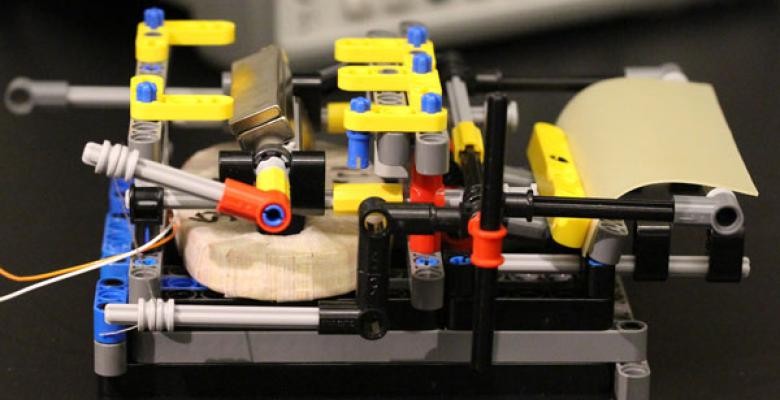Biophysicist Harnesses Power of Evaporation, Discovers Potential New Source of Renewable Energy

Legos may seem like an unlikely foundation for scientific research, but the building blocks have been a part of Ozgur Sahin’s work since he made a mechanical adding device with them when he was 11.
Now Sahin, associate professor of biological sciences and physics, has developed a new machine using the blocks – a prototype generator that can harness the energy of evaporation. “The biggest form of energy transfer in nature is evaporation,” said Sahin. “Our climate is powered by evaporating water from the oceans, and we have no direct way of accessing this energy.”
The basis of Sahin’s research is the bacteria Bacillus, microorganisms commonly found in soil. When starved, Bacillus forms a rigid, dormant spore, a survival mechanism to protect its genetic material. In humid conditions the spores absorb moisture from the air, expanding up to 40 percent in volume. In dry conditions, the process reverses.
“Changing size this much is highly unusual for a material that is as rigid as wood or plastic,” explains Sahin. “We figured that expanding and contracting spores can act like a muscle, pushing and pulling other objects. We noticed that we could harness the motion of spores and convert it to electrical energy.”
In a paper published in Nature Nanotechnology on Jan. 26, Sahin and his team, including collaborators from Harvard University and Loyola University Medical Center, showed that these spores produced a thousand times more force than human muscles, and that even a little bit of moisture from evaporation could cause a movement strong enough to be harvested.
Sahin gathered his favored building blocks and built a prototype generator modeled after a wind turbine, to show that energy from the spores’ movement could be harnessed. The team applied a thin layer of spores to a flexible, elastic rubber sheet and connected it to a turbine generator, which captures mechanical energy and converts it into electricity.
Using a fan and a small container of water, they showed that the dry laboratory air and the evaporating moisture from the surface of water can cause the entire sheet to curl up and then straighten, rotating the turbine back and forth to produce electricity.
“The subtle phenomenon of evaporation has big potential. This may be an opening for a completely new energy platform,” says Sahin, suggesting new ways to produce and store renewable energy, such as environmentally benign batteries.
And unlike solar or wind power, evaporation happens continuously throughout the day and night. The findings also present possibilities to engineer stronger materials that mimic muscular movement in robots and prosthetic devices.
Sahin was encouraged early on to cultivate such creative thinking by his father, a surgeon, and mother, a teacher, while growing up in Ankara, Turkey. After attending college at Bilkent University, he moved to the U.S. in 2001, earning his master’s and Ph.D. at Stanford.
“My parents emphasized the importance of learning new things,” Sahin says. “I always had the mindset that I could make and create things myself.”